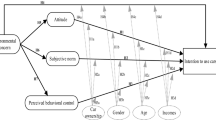Abstract
Smart Cities have received a significant amount of attention in recent years. The East London Smart City Public Safety Project aims to use citizens as an information source in order to report qualitative data in a natural language format. In order for this approach to be successful, an appropriate means of motivating citizens to contribute their observations voluntarily is necessary, and thus the aim of this paper. Motivational factors are identified through a survey administered to participants who have reported public safety matters. The survey is based on the constructs of the Theory of Planned Behaviour, namely: Attitude Toward Participation, Subjective Norm and Perceived Behavioural Control. From this study, it emerges that attitude toward reporting public safety matters and societal pressures are the most relevant factors determining a citizen’s motivation to report public safety matters.
Access this chapter
Tax calculation will be finalised at checkout
Purchases are for personal use only
Similar content being viewed by others
References
Azjen, I.: The theory of planned behaviour. Organ. Behav. Hum. Decis. Process 50, 179–211 (1991)
Bhana, B., Flowerday, S.V., Satt, A.: Using participatory crowdsourcing in South Aafrica to create a safer living environment. Int. J. Distrib. Sens. Netw. 2013, 13 (2013). Article ID 907196
Caragliu, A., Del Bo, C., Nijkamp, P.: Smart cities in Europe. J. Urban Technol. 18(2), 65–82 (2011)
Cilliers, L., Flowerday, S.: Trust in a crowd-sourcing system in order to improve public safety. In: 15th Annual Conference on World Wide Applications, Cape Town, S.A, September 2013
Hammon, L., Hippner, H.: Crowdsourcing. Bus. Inf. Syst. Eng. 4(3), 163–166 (2012)
Nam, T., Pardo, T.A.: Smart city as urban innovation: focusing on management, policy, and context. In: ICEGOV 2011, Estonia, pp. 185–194, 26–28 September 2011
Piderit, R., Flowerday, S., Satt, A : Identifying barriers to citizen participation in public safety crowdsourcing in East London. In: iNEER Conference, Cape Town, S.A, December 2013
Roitman, H., Mamou, J., Mehta, S., Satt, A. Subramaniam, L.V.: Harnessing the crowds for smart city sensing. In: Crowdsens, Hawaii, pp. 17–18, 2 November 2012
Satt, A.: OCR proposal background participatory mobile crowdsourcing. Israel (2011)
Stats, S.A.: Census 2011: key results (2012)
UCLA SPSS FAQ: What does Cronbach’s alpha mean? (2013). http://www.ats.ucla.edu/stat/spss/faq/alpha.html. Accessed 01 August 2013
Author information
Authors and Affiliations
Corresponding author
Editor information
Editors and Affiliations
Rights and permissions
Copyright information
© 2015 Institute for Computer Sciences, Social Informatics and Telecommunications Engineering
About this paper
Cite this paper
Piderit, R., Flowerday, S., McLean, S. (2015). Motivating Citizens to Contribute to the Smart City: A Public Safety Case Study. In: Giaffreda, R., Cagáňová, D., Li, Y., Riggio, R., Voisard, A. (eds) Internet of Things. IoT Infrastructures. IoT360 2014. Lecture Notes of the Institute for Computer Sciences, Social Informatics and Telecommunications Engineering, vol 151. Springer, Cham. https://doi.org/10.1007/978-3-319-19743-2_20
Download citation
DOI: https://doi.org/10.1007/978-3-319-19743-2_20
Published:
Publisher Name: Springer, Cham
Print ISBN: 978-3-319-19742-5
Online ISBN: 978-3-319-19743-2
eBook Packages: Computer ScienceComputer Science (R0)




